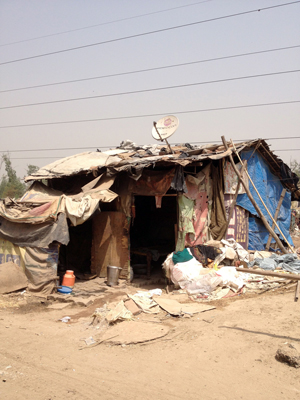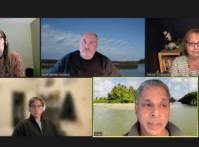-
The New World of Climate Suffering
June 24, 2014 By Paul Wapner
To date, there have been two proposed responses to climate change: mitigation, aimed at stopping the buildup of greenhouse gases, and adaptation, focused on accommodating ourselves to a warmer world. There is a third option, however, that is increasingly relevant: suffering.
No matter how much the world mitigates or takes measures to adapt, increasingly large swaths of humanity are already feeling the consequences of intensified storms, droughts, floods, heat waves, and other hardships associated with climate change.
Increasingly large swaths of humanity are already feeling the consequences of intensified storms, droughts, floods, heat waves, and other hardshipsMany are aware that different parts of the world bear different responsibilities for carbon emissions. Many are also aware that the poor are the most vulnerable to climate changes. What is less known, or at least less appreciated, is the lived experience of this power differential.
During two recent research trips to Nepal and India to study how some of the world’s poorest people are living through the opening chapters of climate change, I witnessed a widening gyre of suffering.
Political scientist Rob Nixon has written eloquently about “slow violence.” This is a type of cruelty “that is neither spectacular nor instantaneous but rather incremental and accretive, its calamitous repercussions playing out across a range of temporal scales.” This is exactly the kind of silent viciousness I saw moving across parts of the Indian subcontinent. For these farmers and villagers, the causal accretions of climate change may be gradual, emanate from across the oceans, and build-up over long stretches of time, but when they arrive, they do so with a vengeance.
Slow Violence
In Nepal and India, nearly 60 and 70 percent of the population, respectively, live on less than $2 a day. Many of these are subsistence or low-producing farmers who practice rain-fed agriculture and live at the edge of economic viability. Nepal gets more than 90 percent of its electricity from hydropower and thus barely contributes to climate change. India, with over a billion people, has one of the lowest per capita emissions rates in the world; its poor make an infinitesimal contribution.
But given unique topographical features and extreme poverty in both countries, Nepal and India are among the most vulnerable to climate-related disruptions and disasters.
This is no longer adaptation but a new kind of social sufferingWorking to record stories of climate vulnerability, I interviewed dozens of Indian and Nepali villagers and farmers in the Himalayas, their foothills, and the nearby plains.
In the mountains, villagers had witnessed glacier lake outburst flooding – a phenomenon where ice and snow walls containing lakes above the timberline fall away due to glacier melt and massive volumes of water are released very quickly, sometimes wiping out entire villages below. They had also experienced landslides as a result of moisture accumulating in the air during droughts and then pouring down with great intensity when it finally did rain.
In the plains, farmers have had to live through scorching heat waves that kill crops and livestock, and leave fields barren as seeds fail to germinate due to prolonged drought. They have also seen some traditional crops fail even in good years as temperatures have risen and biomes have shifted.
On the Doorstep and in the House
The people living through these changes are practicing what could be called a type of climate adaptation but one that doesn’t have to do with higher sea walls, drought resistant crops, or buried electrical lines. Rather, it involves nerves and stomachs.
 Far from social services and lacking material resources to prepare for and recover from climate disruptions, many rural farmers and villagers have had to reduce the variety of their diets, cutting out crops that rely on steady water or simply going hungry.
Far from social services and lacking material resources to prepare for and recover from climate disruptions, many rural farmers and villagers have had to reduce the variety of their diets, cutting out crops that rely on steady water or simply going hungry.Every person with whom I spoke also related psychological strain from living on the economic edge with no assurance that his or her longstanding way of life would continue to be viable. Many expressed shame at not being able to provide for their families and those who had borrowed money felt hopeless in the face of dwindling economic opportunity. To me, this is no longer adaptation but a new kind of social suffering.
What was particularly troubling was the knowledge that I was looking downstream – at those on the receiving end of the rich’s carbon addiction. Like others of the global poor, these people live on marginal lands, in substandard structures, and are exposed to the elements. When climate-intensified storms, floods, droughts, and so forth arrive, they come to the doorsteps, intrude into the living spaces, and enter the very bodies of the poor.
Hardship Has Arrived
The experience of the global poor is, of course, not simply a fact of life but a result of politics. Historical emissions themselves helped create the distinction between the developed and developing worlds. Carbon contributed to the rich becoming rich and designated the poor as “global residuum,” as the urbanist Mike Davis aptly puts it. The divide between the carbonized rich and the rest has grown to such dramatic proportions it now defines the contours of humanity’s third way of responding to climate change, separating (for the moment) the material adaptors from the corporeal sufferers.
None of this is news. The United Nations Framework Convention on Climate Change acknowledges “common but differentiated responsibilities”; the Fifth Assessment of the Intergovernmental Panel on Climate Change discusses vulnerable populations; and, at the last UNFCC meeting in Poland, developing countries called for monetary compensation for loss and damage associated with living on the frontlines of climate change and the receiving end of the developed countries’ carbon appetite.
To these people, hardship is not an event but a chronic conditionInterestingly, when I asked people who is responsible for climate change and who should do something about it, no one blamed North America or Europe or other regions historically most responsible for carbon emissions. They said that such causes were too far away. In fact, they didn’t blame anyone for their climate troubles. To these people, hardship is not an event but a chronic condition. As such, they have nothing to announce as the monsoons weaken and become more unpredictable or droughts persist longer. Their lives are, seemingly as ever, a surface on which hardship is simply recorded and endured.
The international community must do all it can to mitigate climate change and put into place just measures to adapt. But along with this, it must also begin to investigate and find ways of addressing the different modes by which people are living and will live through the slow violence of climate change. We cannot allow the “normalized quiet of unseen poor” to continue, as Edward Said says.
Climate politics is no longer a matter of avoiding pain. Hardship has arrived and it’s spreading.
Paul Wapner is a professor of global environmental politics in the School of International Service at American University. His most recent book is ‘Living Through the End of Nature: The Future of American Environmentalism’ and a forthcoming co-edited volume, ‘Global Environmental Politics: From Person to Planet,’ will be published this fall.
Sources: Davis (2007), Nixon (2013), Said (2008), The Third Pole, UN Framework Convention on Climate Change, The World Bank.
Photo Credit: Farmers in western Nepal, courtesy of Neil Palmer/International Center for Tropical Agriculture. Fragile home, used with permission courtesy of Paul Wagner.
 A Publication of the Stimson Center.
A Publication of the Stimson Center.

 Far from social services and lacking material resources to prepare for and recover from climate disruptions, many rural farmers and villagers have had to reduce the variety of their diets, cutting out crops that rely on steady water or simply going hungry.
Far from social services and lacking material resources to prepare for and recover from climate disruptions, many rural farmers and villagers have had to reduce the variety of their diets, cutting out crops that rely on steady water or simply going hungry.





